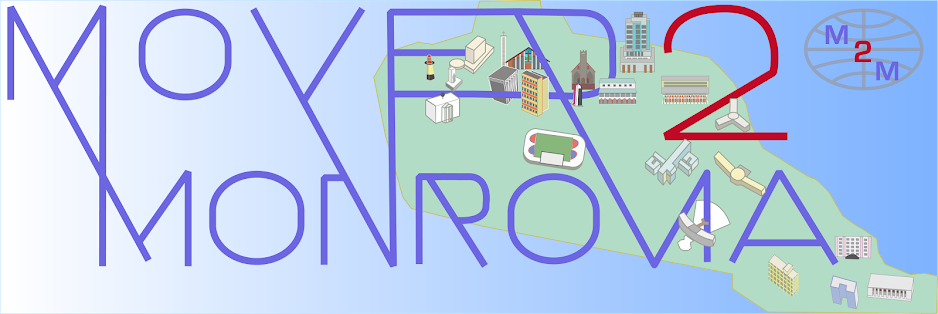I've already posted the building of the month for February, but I have something of another architectural review to post—more like something of a
landscape architecture review.
Monrovia Central Park officially opened last week. The formal name is Chevron Monrovia Central Park —as a major source of funding for the park's realization came from Chevron Liberia Ltd, the local subsidiary of the San Ramon, California-based super major that is working some of Liberia's offshore oil blocks.
Monrovia Central Park isn't exactly central, in the sense that it is not located within the historic core of Central Monrovia, but is across the river, on Bushrod Island, and not far from what up until now has been Monrovia's only park-like setting: the historic Providence Island, which sits forlornly in the middle of Mesurado River, it's tiny surface a half-neglected barrenness bisected by the busy Gabriel Tucker bridge connecting Bushrod Island with Central Monrovia.
Heretofore, Monrovia has not had any other real parks: no dedicated public open spaces, other than the small, over-formal grounds of Centennial Pavillion Grounds There are a few non-dedicated open areas, such as the erstwhile make-shift football pitches at the end of the Spriggs-Payne runway, which were cordoned off in 2011 as the airport re-established control over its periphery. There is also the beach, although those are not exactly treated as public parks either by the public nor government authorities,
who have made moves to wall off many beaches to the public in recent years, as has been previously noted on this blog.
Monrovia Central Park is also not on the same scale as its Manhattan namesake. The postage stamp public garden wouldn't be hosting any carriage rides or ice-skating, even if the climate was more amenable. There's hardly enough space to kick a ball back and forth.
Also, the park suffers from a sort of over-intervention that is actually common to Liberian landscaping. There is far too much concrete, and far too little grass. These rough-shod surfaces take the shape of a surfeit of sidewalks and low walls, sitting areas where even the benches and tables are crudely cast in cement. This echoes the inner courtyards of many private residential and hotel compounds in Monrovia, which are often paved over into an unwelcoming expanse of hard surfaces, radiating heat.
There are some nice features added to the park, including several playground areas with slides and swing sets. The most monumental aspect is an enormous two-story palaver hut, the largest I've ever seen. There a number of smaller, thatched-roof stands around the perimeter, like picnic pavilions.
There is still a fair amount of grass and large trees, which is definitely a worthwhile amenity, and all-too-rare in comparison with most of Monrovia's compounds. Perhaps the most successful detail is the waterfront pavement, which acts as a sort of riverside promenade, which even includes a boat dock, perhaps for a future water taxi service, but also utilizes the Park's location, with a pleasant vista across the wide mouth of the Mesurado, looking south towards historic Central Monrovia and Providence Island.
Hopefully, Monrovians will be able to make use of the park, especially young children, and hopefully this is only the first open space that is formally set aside for the city's residents. Excerpted from the Executive Mansion press release:
The President challenged the Monrovia City Corporation (MCC) to ensure that the Mesurado River is cleared of garbage, to allow those boating to have a garbage-free environment at all times...
The President seriously frowned at the Waterside section of the river, where makeshift latrines are built along the bank, terming them as unacceptable and should be removed immediately.She also instructed the committee to include the clean-up of Providence Island, to make it a tourist attraction and, at the same time, to complete the construction of the monument on the island. When completed, the monument will address one of the recommendations of the Truth and Reconciliation Commission that such a structure be erected in honor of those who paid the ultimate price for peace in Liberia.President Sirleaf encouraged parents to join the government and its partners in the effort to create an enabling environment for Liberian children. The park, she said, will go a long way in allowing the Liberian child to play once again, where they will know no war. She called upon parents to be good partners in achieving this objective.









No comments:
Post a Comment